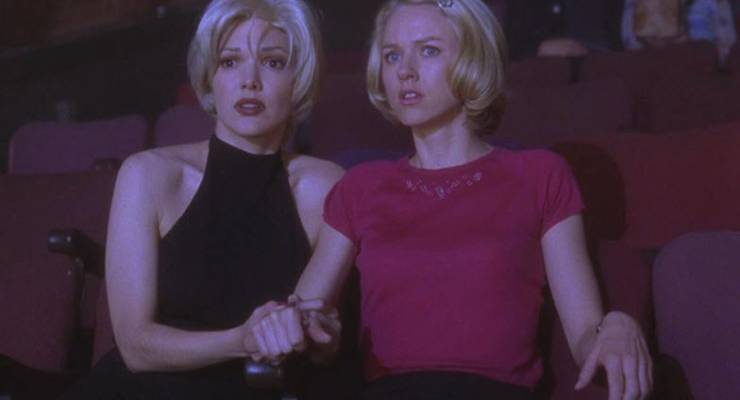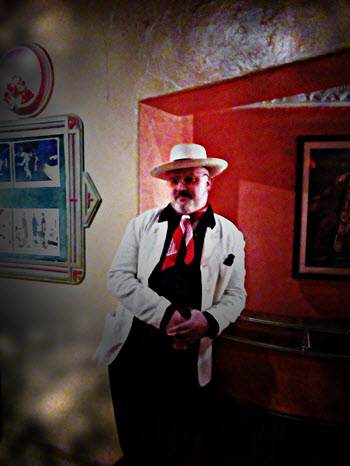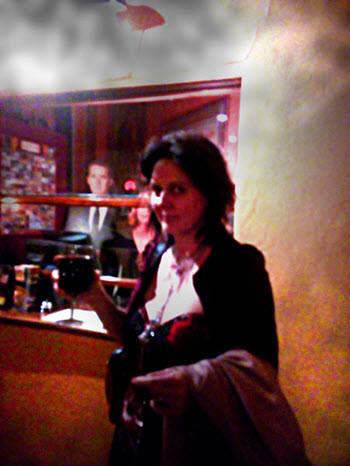
The winter sky was raging, the trams rattled down through Prahran, and the corner of Chapel Street and Dandenong Road was suffused with a soft glow, as the Astor cinema lit up for the occasion of all occasions, perhaps its defining moment.
Three quarters of an hour before showtime, and the queue was already coming out the row of deco doors at the front of the behemoth. They were greasy-haired cineaste men with scrabbly beards, elegant couples turned out in ’40s style, and pairs of female friends maybe thinking of taking it that one stage further.
This was no simple cinematic event, no mere showing. This was a hallowed act of obeisance, cinema vanishing into itself: the Astor, a vast dome of faded theatrical glory was showing David Lynch’s Mulholland Drive, a sort of giant plughole of the Hollywood myth, into which all meaning vanishes.
The Astor had been playing the entire Lynch oeuvre every Monday for two months, an act that verges on the redundant. In the foyer of the Astor, the art deco lamps emit a slow hum, the couches — corduroy and cashmere-ish — invite one in with the same fetish beguilement as they emit in Blue Velvet and Lost Highway, the characters come and go and change form as they do.
“I’ve seen it three times,” said Genevieve, in the Astor’s bar. She’d really rocked it out, in the style of “Rita/Camille”, the Bettie Page style-alike, whose staggers into neophyte actress Diane’s borrowed apartment and starts the whole shebang out. Had the special effort taken her long? “No, I always dress like this.” She was a philosophy student, as was half the audience here.
“I think I have seen it eight or nine times,” said Gerhardt, who had definitely styled himself as “the cowboy” whose multiple appearance presages doom for all concerned.

“You’re German? What do you do?”
“I’m a philosopher, at History and Philosophy of Science at Melbourne University.”
“Where from in Germany?”
“From Jena.”
“Ah Hegel’s old gaff.”
He brightened.
“Yes.”
“Did you first see it in Jena at a crumbling old cinema redolent of the tragic split between history and image in a ravaged continent?”
“No, at the Multiplex.”
“What’s a Hegelian take on Mulholland Drive?”
He thought. For quite a long time.
“It is anti-Hegelian. Wittgensteinian. ‘See! Then think!'”
I didn’t think I’d stay. I’ve seen this damn film 11 times. The last thing I could spare was the time.
I bought a ticket. Decided I’d see the first half-hour, get the feel.
In the queue, Emma and Steph were waiting for choc-ices. Even the choc-ices acquire an occult dimension at a Mulholland Drive showing. Cinema is strange, it’s a strange thing to do, and the film brings that front and centre, revives it endlessly. Steph had seen the film three times; Emma had never seen it (or maybe it was the other way ’round; notes are faulty, identity is fluid). “Oh, I envy you,” I burst out.
Emma, or Steph, was a film student. Steph, or Emma, worked at Coles.
“You work at Coles!”
“Yes but I’m studying philosophy.”
We all went in. The Astor’s fanfare started, with its ancient glass intro slide, a relic of the cinema’s earliest days, a Voguish woman, with two Afghan hounds in tow, standing beside a Daimler. I choked up, as I always do. This upper gallery was full, on a winter Monday night. The film is on Netflix.
Everyone was here for one reason only: to see it together, to touch the veronica of it, this strange wonder that, at some point in your life, cinema may stir in you, to bear the nuisance of a worn print, people shaking sweet packets, shuffling to the toilet, the experience. Some get hooked for life — for most, it fades. This was one visit back to it, to years spent seeing obscure film noirs in corporate theatrettes hired by cinema clubs, combing the TV listings for 3am showings of Barbara Stanwyck B movies.
I stayed for the whole of it, of course. No question I wouldn’t. For the crash, Rita and Betty’s strange meeting, for the sizzling, strange audition scene, the mysterious sequence of phone calls from one velure-carpeted room to the next, for “this is the girl”, for the Sylvia North Story scene, for the appearance of the blue key that takes the film back to Maya Deren’s Meshes of the Afternoon (of which it is a reading), and then at Club Silencio, whose appearance doubled the Astor exactly, so it was as if we were staring into a mirror. Rebekah Del Rio began ‘Crying’ in Spanish, and the place went so quiet you could hear the projector purr and whirr, and ah of course I had never realised it before, cinema itself is “Club Silenzio”, the scene is the thing itself. OK, Lynch is a genius. See, then think.
We streamed out, we lingered, we pondered. Rose posed for me in front of the Astor’s famous cut-outs.

Did she have a theory of it?
“No, it’s just like letting someone else’s dream wash over you. When I work it out, I’ll stop seeing it.”
Profession?
“Writer.”
She seemed to vanish into the mirror. I waited for the last tram, expecting it might be an old green rattler, its domino-face lights poking through the dark, taking me back. Silencio.








yes, cannot count the number of times I have watched it on my home DVD copy, do they wear out? .. sometimes just jump straight to silencio and assume the stunned mullet position, no thinking required
One thing we do share, Guy, is love for “Mulholland Drive”, which my good wife and I saw years ago at Circular Quay and spent hours afterward mulling over its meaning. Obviously fuel for philosophers. Haven’t seen it again, though. Perhaps my good wife I should hire a DVD?
Twice in a week I’m with you 100%. Is this a record?
I couldn’t work out for sure whether it was you or Rose who will stop watching the film when it’s been “worked out”, but I would guess it was Rose. Assuming it was, I hope you didn’t tell her that there’s nothing to work out, it just is what it is, a sequence of sequences, each to be appreciated in itself.
Would I be right in guessing that you’re a fan of Robert Altman’s “The Player”? If so, how about a piece on that? It’s Altman’s best by a mile, IMHO.
robin
i reckon there’s something to work out – but it’s an escher picture, a flow of events that never cohere into a consistent picture.
My favourite Altman is ‘McCabe and Mrs Miller’ – another dream picture….
I’d put The Player ahead of McCabe and Mrs M, and Short Cuts is up there too. Three Women is the dreamiest of the lot and has stuck with me for 40 years. MASH is pretty funny.
I liked the photos in your piece, more please! Also, if Rose’s generous glass of red is the norm pour at the Astor, I’m there on a wintery Monday night!!!
That balloon/dirigible of red caught my eye too – but then it is the Athens of the South (to its deluded denizens), where hemlock often seems preferable.
The only time I see films within a year or two of their release is at 30,000 feet.
Visiting friends with both a TV/DVD and a taste for arcane films this week, I’ve seen, for the first time ‘Performance’ and “Saturday Night Fever’.
Both took me back, one to a dream of halcyon daze, tuther to an arid wasteland of nightmare.